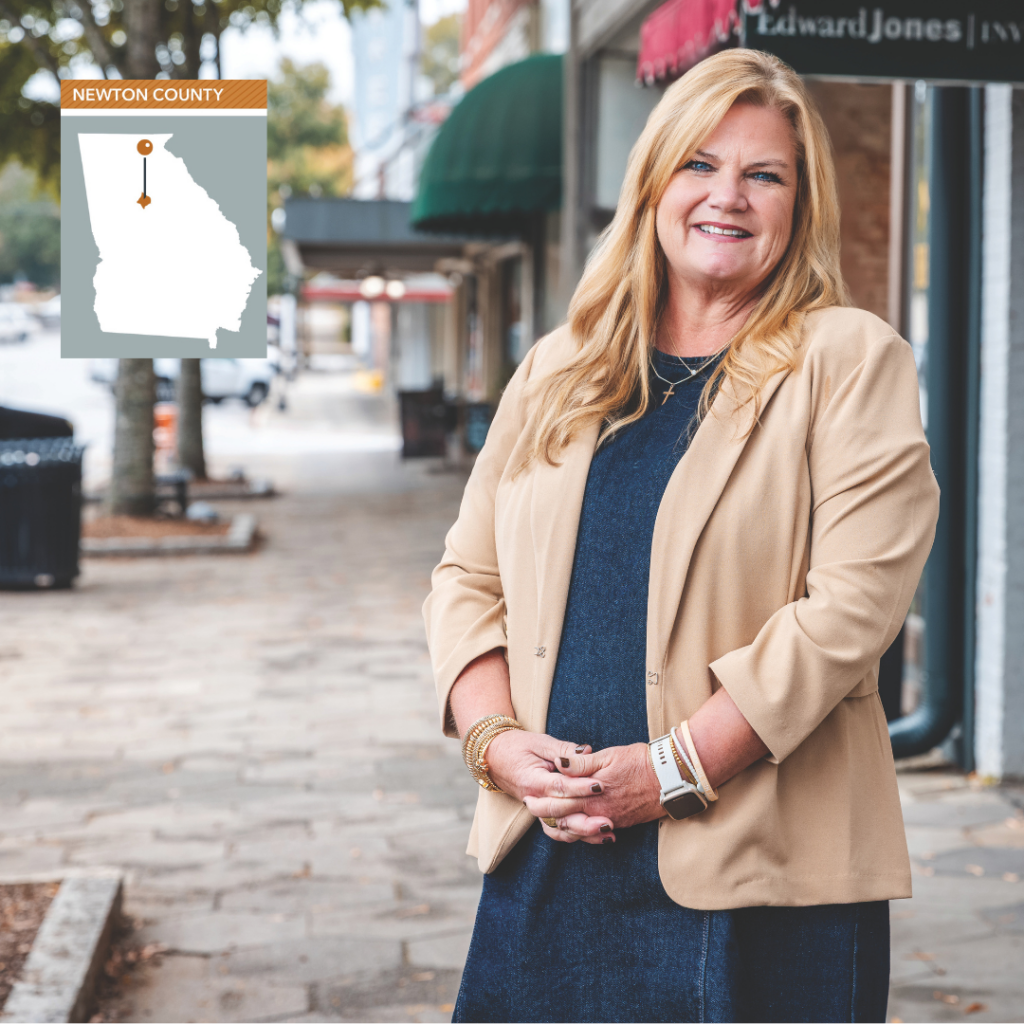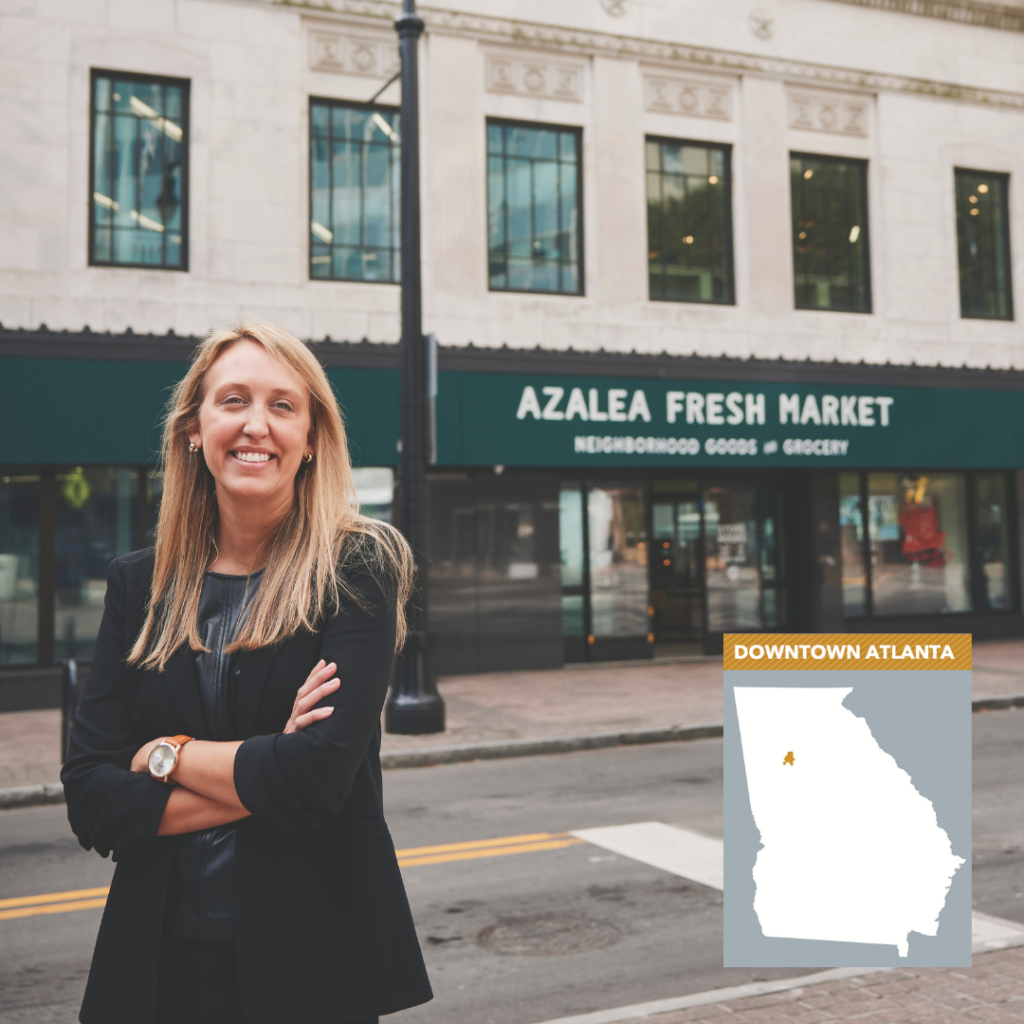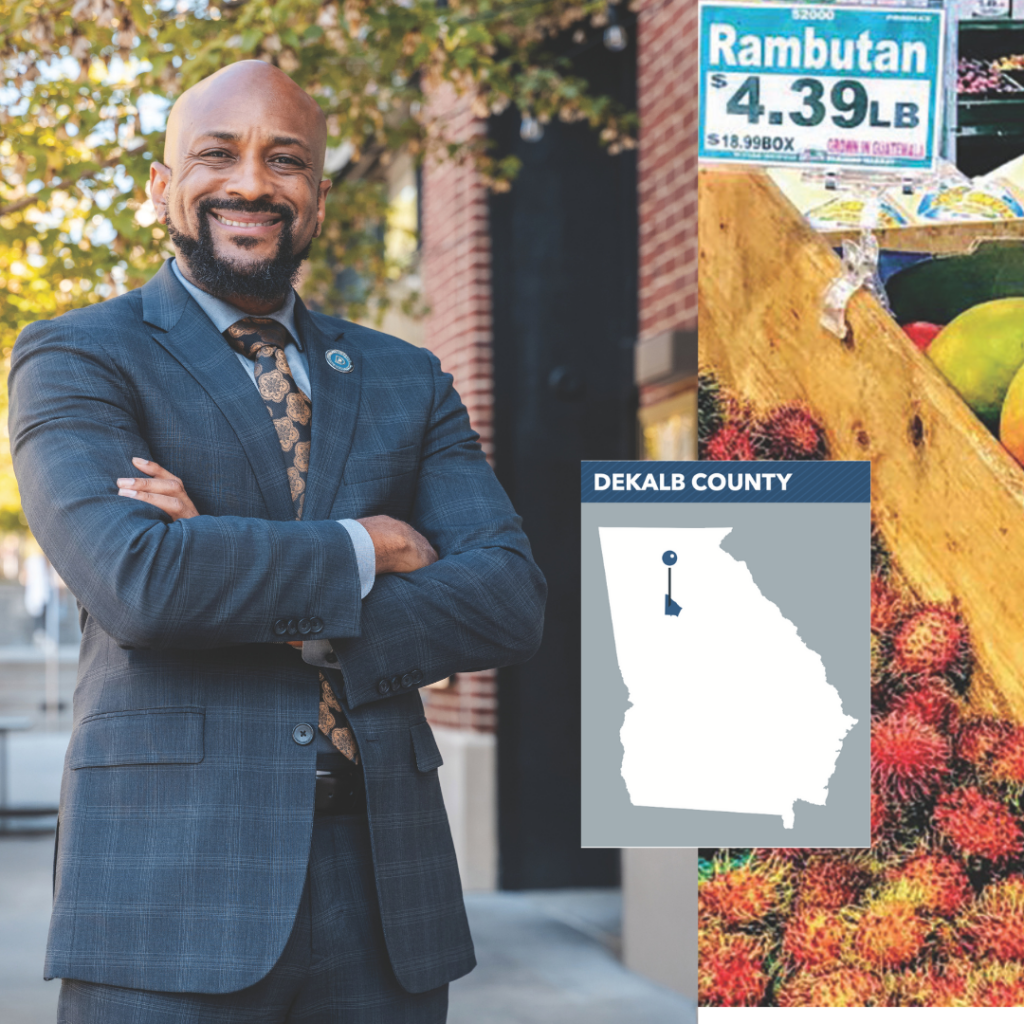DeKalb County | Strong Growth and Successful Projects
Diving into DeKalb
Ask anyone about DeKalb County and you’ll hear tales of resilience, revitalization, business growth, infrastructure improvement and overall optimism for what’s to come.
DeKalb CEO Michael Thurmond attributes part of the county’s business success to the heavy rail rapid transit system brought about by visionary leaders nearly four decades ago. “Ours was the only suburban county that [initially] supported the referendum and saw beyond the divisive rhetoric that was associated with the establishment of the Metropolitan Atlanta Rapid Transit Authority [MARTA],” he says. “Now we have Gen X and others who flock to mass transit, and it was supported with a one-cent sales tax.”
Thurmond also touts the redevelopment of North DeKalb Mall. Real estate developer Edens is transforming the 73-acre site, now called Lulah Hills, into a mixed-use development that will include 2.5 million square feet of retail, along with townhomes and multifamily housing, a hotel and a multiuse trail connecting to Emory University and nearby neighborhoods.
Thurmond cites PepsiCo’s expansion of its bottling plant in Tucker as another boon for the county. “This will include at least 136 new full-time jobs, bringing the company’s total workforce in DeKalb County to more than 600 employees,” he says, adding that the facility will expand by more than 260,000 square feet, making it one of Pepsi’s largest manufacturing plants. Pepsi reports that the plant’s production will quintuple due to the expansion, which is slated to be completed by 2024.
Decatur, the county seat famed for its historic courthouse and restaurant-lined square, is growing, too.
Mayor Patti Garrett says that in 2022-2023 the city, with a population of 24,338, gained a total of 36 new businesses. “To support local businesses, the Decatur Downtown Authority [DDA] awarded $100,000 in commercial façade improvements to 17 small businesses in the first half of 2023 and is committing to another $100,000 in grants slated to be distributed in fiscal year ’23-’24,” says Garrett, adding that at 4.7 square miles the city is small, but it reaps the rewards when DeKalb does well.
“It’s always a win-win for us to see successful projects and strong growth in DeKalb County. We have a mutually supportive relationship with the county that is enhanced, I think, by being the county seat,” she says.
Food and Film
Doraville, with a population of 10,888, is another Atlanta suburb on the move and, according to Mayor Joseph Geierman, is home to one of the Southeast’s most prosperous communities of immigrant-owned small businesses. “If you look back to the 1980s, you’ll see that Korean and Chinese immigrants moved in, followed by other Asians and later Latino business owners who revitalized the area with retail, wholesale and restaurants,” says Geierman, adding that people view Doraville, with some 150 restaurants, as a foodie destination.
Geierman adds that the city also has a big manufacturing and industrial base. “A large majority of gasoline is distributed from Doraville. They have people here maintaining facilities for companies like Chevron,” he says.

Mall Makeover: Rendering of Lulah Hills, a mixed-use development being built at the former North DeKalb Mall: photo contributed.
The area has had its ups and downs. When the General Motors plant closed in 2008, the community felt the loss, but the site has been transformed into the mixed-use Assembly Atlanta. Third Rail Studios was one of its first tenants, building its film studios at the old plant site, followed by Gray Television, which announced plans to add up to 10 film studios, residences and a hotel. “They’ve built 19 sound stages; it’s going to be one of the bigger movie and television production facilities in Georgia,” says Geierman. Gray acquired Assembly Atlanta and Third Rail Studios in 2021.
Adding to the enthusiasm for the film industry in the county is the Shadowbox Studios (formerly Blackhall Studios) expansion project in South DeKalb. According to Dorian DeBarr, president of Decide DeKalb Development Authority, plans are in the works to invest $380
million in the expansion to “unlock the economic value of a historically challenged 150-acre site.” DeBarr says that the expansion will create Georgia’s largest studio complex and increase the county’s available studio space to well over 3 million square feet, bringing 2,400 high-paying film and production-related jobs to the area.
Along those same lines, at least when it comes to “historically challenged” sites, Decide DeKalb is using its expertise to add a new tool to the developers’ toolbox so they can not only identify available brownfields, but also qualify for funding to clean them up for reuse.
“This project will yield tremendous rewards for the county’s businesses and residents,” says DeBarr, adding that too many opportunities are lost or on hold because properties are just sitting there when they could be used for so much more. “These areas can be improved for commercial use or the enjoyment of our residents as we see with the East Decatur Greenway, which went from brownfield to a recreational resource for DeKalb residents,” he says. Opened in 2018, the East Decatur Greenway transformed a former abandoned gas station into an oasis for birds and wildlife, with a 1.1-mile trail segment built in partnership with the PATH Foundation connecting the site to the Avondale MARTA station redevelopment nearby.
Chamblee Mayor Brian Mock echoes other officials in touting the many projects that are underway in his city of 29,869 residents. “We are the fastest-growing city as determined by the 2020 census,” says Mock, pointing out that Chamblee is keeping abreast of the growth with
housing plans. “We built more than 2,000 units in the past five years, and equally as many are currently under development. We also just finished an affordable housing strategy,” he says.
Mock, who calls Chamblee a big city with a small-town flavor, says the Buford Highway community – home to one of the highest concentrations of foreign-born residents in the country – ensures that visitors have access to a wide range of global cuisine without leaving the country.
“We have a ton of new restaurants in our revitalized downtown, along with brewpubs and distilleries and even an indoor golf range,” he says. “With the Assembly project, you may even see a few movie stars.”
Mock also mentions a recently completed trails master plan. “This connects the city from one side to the other so that 80% of the city’s residents will be within five minutes of being connected to a network of stores and restaurants without ever having to get into a car,” he says.
Meeting the Challenges
Clouds often accompany silver linings when a county is growing and thriving. That cloud is often in the form of old infrastructure that struggles beneath the weight of an area’s success.
Thurmond notes that inflation doesn’t help matters when dealing with the cost of upgrading such infrastructure. “What we’re trying to do is preserve a quality of life, which includes investing in water and sewer infrastructure that is currently in disrepair,” he says. DeKalb has been under a federal and state consent decree to fix its decaying sewer system. “In 2020, we were able to negotiate a modification in that decree to spend $100 million a year to repair, replace and upgrade the water and sewer system. Prior to this we didn’t have the capacity to grow new industry or single or multifamily housing,” Thurmond says. That changed in 2017 thanks to a new penny tax that was approved by the voters. That special purpose local option sales tax (SPLOST), which runs until 2024, will generate approximately $600 million a year for capital improvements.

Connectivity and Collaboration: Malaika Rivers, partner with Lexicon Strategies and executive director of the Chamblee Doraville Community Improvement District (CID).
Malaika Rivers, partner with Lexicon Strategies and executive director of the Chamblee Doraville Community Improvement District (CID), says that part of the organization’s responsibilities includes smaller jobs, like filling in sidewalk gaps. Larger projects include working on intra-district connectivity and collaborating with the state department of transportation and the city of Chamblee to identify areas and tap into state funds available for public safety.
One important effort in the works is the Peachtree Boulevard Gateway improvements project, which involves a realignment at the intersection of Peachtree Boulevard at North Shallowford and Peachtree roads. “It’s an area where five streets come together, and it is wide and very confusing,” says Rivers, explaining that, in addition to the realignment, the CID will work to involve a multi-modal component to the area so that it can be traversed via bike, foot or car.
“This, in turn, will connect to a regional trail that is being planned,” says Rivers. The roadway project, which is estimated to cost $3.7 million, has been awarded $1.5 million in federal funds.
Legacy infrastructure is another focus for the CID. “Our area has a lot of it, from freight lines to transit lines, all which run through the community,” she says, adding that the CID is working on intra-district connectivity and making sure that when people visit the area, they have a seamless experience. Rivers estimates that upwards of about a dozen projects are currently in the queue to be considered. “Our board of directors, comprised of commercial property owners in the area, will determine which of those they want to advance,” she says.
Attracting Tourists
As the county grows, so does the demand for more hotels. Some that have opened in recent years include the Holiday Inn and Suites in Chamblee with 143 rooms, the Residence Inn in Decatur with 120 rooms and Tru Hotel in Tucker with 98 rooms.
According to Siri Emereje, marketing manager for the county convention and visitors bureau Discover DeKalb, the area’s biggest attraction continues to be Stone Mountain Park, a 3,200-acre destination. Emereje reports that the park alone attracts 4 million visitors per year.
Stone Mountain Park hosts several signature events, such as the Yellow Daisy Festival featuring arts, crafts and music. An annual pumpkin festival held during the fall features pie-eating contests, pumpkin carving, rides aboard the Scenic Railroad and a park that is illuminated at night with thousands of glowing lights. In November, Stone Mountain holds a Native American Festival and Pow Wow, and later in the month the destination ushers in the holidays with Stone Mountain Christmas featuring millions of lights, live shows and visits from some of the kids’ favorite holiday characters. Probably the biggest event is the annual Fourth of July fireworks show.

Arts Center: The Exhibition Hub presented Claude Monet: The Immersive Experience in 2022: photo contributed.
A unique experience awaits at the Exhibition Hub, which recently opened a new 50,000-square-foot immersive arts center in Doraville, just outside I-285. John Zaller, executive producer for Exhibition Hub, says that a lot of thought was put into where the center would be before he chose the five-acre location near the Assembly project. “The region has welcomed us with more than open arms, and we look forward to bringing cutting-edge entertainment here for years to come,” says Zaller.
Additional attractions in DeKalb include the Starlight Drive-In, which dates back to 1949 and is open seven nights a week year-round; the Flat Rock Archives Museum in Stonecrest where individuals can learn about rural African American history; and the DeKalb History Cente at the DeKalb County Courthouse, also in Decatur.
Events in the county throughout the year include Tucker Restaurant Week in February, Chamblee Restaurant Week in April and a summer concert series that runs from June through August, held in Chamblee. There’s also the annual Lakefest held in October at Pine Lake, with arts, crafts, music, vendors, food trucks, games and more.
According to Emereje, tourists spend about $1.28 billion a year in the area.
Taking into account everything that is happening in DeKalb, it’s easy to see why so many live, work and play in the region. Says CEO Thurmond, “Our future looks bright indeed.”
Local Flavor

Commemorating the Original: Cardboard cutouts of Waffle House co-founders Thomas Forkner and Joe Rogers Sr. at the Waffle House Museum, housed in the chain’s first restaurant: photo Waffle House Museum.
Waffle House Pilgrimage
Waffle House is an Iconic and beloved institution, an always-open place where a side of friendliness is served with every heaping helping of hash browns – scattered, smothered, covered, chunked or just about any other way you please.
The Waffle House Museum in Avondale Estates commemorates the company, which touts 2,000 restaurants spanning 25 states. It’s housed in the very first Waffle House, which was opened in 1955 by Joe Rogers Sr. and Tom Forkner.
The building has been restored to look like the original restaurant, which operated from 1955 to 1975. Since opening in 2008, the museum has attracted both locals and out-of-towners to pay homage to this slice of Americana.
Former Museum Director Virginia Angles offers free tours every other Wednesday. “We stopped for a while due to COVID, but we’re back up again and capping tours at 20 people for now, although we’re working on making them more accessible in the future with additional hours,” she says.
As museums go, this one is relatively small, with half of the 1,700-square-foot building re-created to look like the restaurant and the other half dedicated to memorabilia and artifacts. Among the items guests will see are uniforms from throughout the years, complete with holiday ties, books, historical photographs and more, says Angles.
Visitors also learn about Lucy Shelton, a dedicated employee who became the longest-serving hourly associate. “She stayed with us for 47 years before retiring in 2004. She loved her community and knew everyone’s name,” says Angles.
Jens Johansson is a travel consultant and parent who is constantly looking for unique and kid-friendly places to explore. “We love Waffle House, and I thought it would be a fun way for the kids to learn about a restaurant that they enjoy, while also getting a dose of local history,” says Johansson, adding that the most memorable part of the visit was when his children pretended to be chefs and served up some orders to mom and dad. “It was a great way for them to engage with the exhibit,” he says.
This is why the company has embraced the saying that “it’s not just a tour, but a pilgrimage.”
For those who aren’t available on Wednesdays, the museum opens periodically on weekends, with the next open house being held the second Saturday in December from 11 a.m. to 2 p.m.












